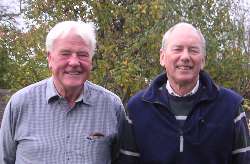POSTED ON.
Short Sleeved Shirts
I did my studying at Leeds University and am one of the small remaining band who are entitled to be a member of the Corium Club via an agreement that on the termination of leather teaching at Leeds the Atkin section of the Procter Society would be absorbed into the Corium Club. University as a student seems a long time ago but I can distinctly remember that November often began with snow. For Bob Higham (Leathersellers 1959) and his colleague Clive there was no such chill and as they embarked on the next leg of their journey from John o’Groats to Lands End for his Charity around Chennai in India (www.littlemistymusic.com/imf/new/trustees.html). During the summer he has been out in India looking at the work they have been doing and there seems no doubt that with limited funds they have achieved a great deal in education and homes for children.
I wrote about Bob’s little adventure back in May and it just shows you that in November they end up with warmer and drier weather than in May, with Bob walking mostly in a short sleeved shirt. Whether it is global warming or an Indian summer people are changing what they do.
Marching through Somerset in England to gather funds for ex-goldfield and tanning areas in India seems not at all unusual in this very connected world today and no leather conversation in Northampton these days cam avoid flowing from China to Brazil as we fit the pieces together of the world leather jigsaw.
The connected industry
It is just this curious complex matrix which we are now studying as a new project with UNIDO to look at the next 25 years. Most studies of this sort in the past have been about the steady evolution of past trends, with certainly the accelerated decline of vegetable tanning with the loss of sole leather, the increasing demand of automobile leather, and the rush of everything into China. Yet all these were in a way foreseen and foreseeable. Now the future looks more about discontinuities as we adjust for a planet that is too small for the growing population and global warming which as we have just seen is already changing what and how we do things. Will there be life after China, and if so where? Is there another tannage on the horizon to replace chrome? And what happens if we run out of leather -which end uses will be the first to go.
The leather industry was always global with hides and skins, plus famous leathers such as Russian, Cordovan and Moroccan, traded for centuries but now each country is looking over its shoulder at what its place might be in the future. Tanning and the use of leather creates a lot of jobs, and shoe making and garment making does so without huge capital expenditure with technologies that can be managed. They are attractive industries and now is the time to for each country to be considering what it has to offer.
Hopping Along
Allied to this is the potential shortfall in raw material, especially quality raw material. This is likely to bring a requirement of some new definitions of quality in leather – that a scratch is not always bad. Even more importantly it is likely to bring more marginal raw materials into play. Think of kangaroo and camel. The Paris Forum talked about leather industry PR but no initiative was taken. Now is the time that the industry needs to start presenting good science as to why it is correct and appropriate to use such raw material.
Mike Redwood
6 November 2007
